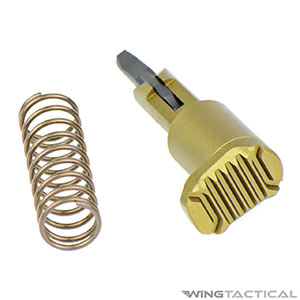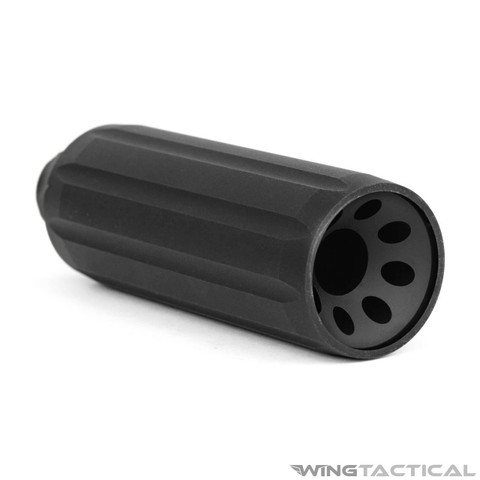The AR-15 forward assist is located on the right side of your rifle, directly under the charging handle. It gives the operator a mechanical way to push the bolt into the battery if a round isn't seated correctly.

AR-15 Forward Assists: A Debate Among Gunsmiths
One of the biggest debates AR owners have is the necessity of the forward assist. Half of the AR community sides with the Army, saying that the forward assist serves an essential purpose and makes the platform more reliable. In contrast, the other half says the forward assist is useless.

Forward Assists
The AR forward assist can help force a round to seat in the chamber, keeping your rifle operational even if there’s dust or debris in your action. Typical forward assists are small and round, and shooters should be able to reach them easily while shouldering the weapon.

Extended Forward Assists
Since the AR-15 forward assist should be easily reachable while the rifle is shouldered, some shooters may need a longer button for easier reach. Extended forward assists can offer easier access for shooters with smaller hands or make the forward assist easier to find just by feeling.

Lightweight Forward Assists
If you want to reduce your carry weight, you might be interested in a lightweight forward assist. While a lightweight model will only negligibly reduce your carry weight, pairing one with multiple lightweight parts (like takedown pins and castle nuts) could help you lighten the load of your overall build.
Wing Tactical: Your Top Source for AR Parts and More
If you’re looking for an AR-15 forward assist for your next custom rifle build, you’ve come to the right place. Wing Tactical sources the best firearm parts available on the market today, and our curated collection is designed for hobbyist gunsmiths, military personnel, first responders, and civilian shooters alike.
Have a question about our collection? Want to talk through your next build? Reach out to our customer service team for prompt and friendly support. We’re always happy to help!
Frequently Asked Questions
Where did the forward assist come from?
The AR platform introduced the forward assist on the military's demand. It wasn't part of Eugene Stoner's original design, and he believed they were unnecessary. The original design of the AR-15 did not feature a forward assist, and when the US Air Force adopted the AR, they didn't ask for a forward assist either.
At that time, the US Army was using the M-14 as their official rifle, which was a modernized version of the M1 Garand. Both rifles featured an operating rod, which could be pushed to put the rifle into the battery if the round did not sit properly. The Army wanted the same feature to be a part of their new rifle, which is why Colt added it to the Military M16s. Since then, every M16 and almost every civilian AR-15 has a forward assist.
Is a forward assist necessary?
A round may fail to seat in the chamber for multiple reasons. First, it could be because the bolt is not traveling forward completely due to dirt or debris. In such a situation, the AR forward assist can be helpful to some extent since it can quickly allow you to force the bolt into the battery. Secondly, a round may fail to seat because there is something wrong with its dimensions. In such a situation, forcing the round into the chamber using the forward assist may actually have a negative impact and cause the round to get stuck in the chamber, causing a catastrophic failure.
This is why people who don't believe in the necessity of the forward assist say that it is better to simply eject the round using the charging handle if it is malfunctioning. Moreover, you can judge whether a forward assist is necessary by thinking about how many times you have actually used it to clear a malfunction.
So, the designer of the AR platform didn't believe that the forward assist was a necessity. However, having one doesn't do you any significant harm either. Also, if your upper receiver already has a forward assist slot, it is best to install a forward assist since dust and debris can get into the action and cause malfunctions. If you don't like the forward assist, you can use a minimalistic or slick upper receiver, and your rifle will run as reliably as any rifle with a forward assist.
Do all AR-15s have forward assists?
While factory-built AR-15s typically feature forward assists—and every M16 rifle manufactured for military use has one—custom-built ARs don’t always feature a forward assist.
How do you install a forward assist?
You’ll need a small pair of pliers and a mallet to install a forward assist. Start by partially inserting the roll pin into the hole above the forward assist slot. Slide the spring over the foot of the forward assist, then pull the spring back to reveal the flat side of the foot. Insert the forward assist into the slot with the flat side facing the roll pin, then hold the forward assist in the slot while malleting the roll pin until it’s flush with the top of the slot.
Rounds aren’t seating correctly in my AR — what should I do?
If your rifle consistently misfeeds or doesn’t seat rounds correctly, consider:
- Switching ammunition – Even though it might be the right caliber, not all ammunition cycles well in all actions. Consider switching casing materials or projectile types.
- Cleaning ammunition and magazines – If you’ve been storing your ammunition or magazines outside or moving them in and out of your backpack frequently, dust or debris might accumulate in the magazine or on the ammunition. While your action can withstand some grit, ensure your ammunition and magazines are clean and serviceable before loading them into your rifle.
- Cleaning your action – If you’re having trouble cycling, it might be time to clean, remove rust, and re-oil your rifle.






